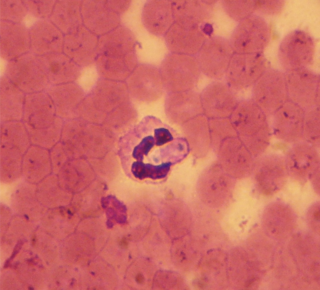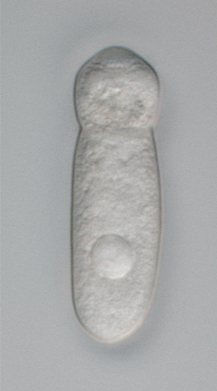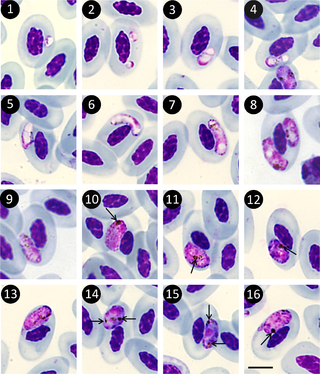Related Research Articles

The Apicomplexa are organisms of a large phylum of mainly parasitic alveolates. Most possess a unique form of organelle structure that comprises a type of (non-photosynthetic) plastid called an apicoplast—with an apical complex membrane. The organelle's apical shape is an adaptation that the apicomplexan applies in penetrating a host cell.

Plasmodium is a genus of unicellular eukaryotes that are obligate parasites of vertebrates and insects. The life cycles of Plasmodium species involve development in a blood-feeding insect host which then injects parasites into a vertebrate host during a blood meal. Parasites grow within a vertebrate body tissue before entering the bloodstream to infect red blood cells. The ensuing destruction of host red blood cells can result in malaria. During this infection, some parasites are picked up by a blood-feeding insect, continuing the life cycle.

Hepatozoon is a genus of Apicomplexa alveolates which incorporates over 300 species of obligate intraerythrocytic parasites. Species have been described from all groups of tetrapod vertebrates, as well as a wide range of haematophagous arthropods, which serve as both the vectors and definitive hosts of the parasite. By far the most biodiverse and prevalent of all haemogregarines, the genus is distinguished by its unique reciprocal trophic lifecycle which lacks the salivary transmission between hosts commonly associated with other apicomplexans. While particularly prevalent in amphibians and reptiles, the genus is more well known in veterinary circles for causing a tick-borne disease called hepatozoonosis in some mammals.

The gregarines are a group of Apicomplexan alveolates, classified as the Gregarinasina or Gregarinia. The large parasites inhabit the intestines of many invertebrates. They are not found in any vertebrates. Gregarines are closely related to both Toxoplasma and Plasmodium, which cause toxoplasmosis and malaria, respectively. Both protists use protein complexes similar to those that are formed by the gregarines for gliding motility and for invading target cells. This makes the gregarines excellent models for studying gliding motility, with the goal of developing treatment options for both toxoplasmosis and malaria. Thousands of different species of gregarine are expected to be found in insects, and 99% of these gregarine species still need to be described. Each insect species can be the host of multiple gregarine species. One of the most-studied gregarines is Gregarina garnhami. In general, gregarines are regarded as a very successful group of parasites, as their hosts are distributed over the entire planet.

Monoxenous development, or monoxeny, characterizes a parasite whose development is restricted to a single host species.

The Haemosporida are an order of intraerythrocytic parasitic alveolates.

Perkinsids are single-celled protists that live as intracellular parasites of a variety of other organisms. They are classified as the class Perkinsea within the monotypic phylum Perkinsozoa. It is part of the eukaryotic supergroup Alveolata, along with dinoflagellates, their closest relatives, and another parasitic group known as Apicomplexa. Perkinsids are found in aquatic environments, as parasites of dinoflagellates and various animals.
The Archigregarinorida are an order of parasitic alveolates in the phylum Apicomplexa. Species in this order infect marine invertebrates — usually annelids, ascidians, hemichordates and sipunculids.
The Neogregarinorida are an order of parasitic alveolates in the phylum Apicomplexa. Species in this order infect insects and are usually found in the fat body, hemolymph, hypodermis, intestine or Malpighian tubules. The most common site of infection is the fat body: many species are pathogenic for their hosts.
The Eugregarinorida are the most large and diverse order of gregarines — parasitic protists belonging to the phylum Apicomplexa. Eugregarines are found in marine, freshwater and terrestrial habitats. These species possess large trophozoites that are significantly different in morphology and behavior from the sporozoites. This taxon contains most of the known gregarine species.
Veloxidium is a genus of parasitic alveolates in the phylum Apicomplexa. Species in this genus infect marine invertebrates.
Filipodium is a genus of parasites in the phylum Apicomplexa. Species in this genus infect marine invertebrates.
Meroselenidium is a genus of parasitic alveolates in the phylum Apicomplexa. Species in this genus infect marine invertebrates.
Siedleckia are a genus of parasitic alveolates in the phylum Apicomplexa. Species in this genus infect marine invertebrates.
Apicystis bombi is a species of parasitic alveolates in the phylum Apicomplexa. It infects bees, especially bumblebees. It is believed to have a cosmopolitan distribution in bumblebees and a sporadic occurrence in honey bees, and causes disease symptoms in nonresistant bee species.
Aseptatorina is a suborder of parasitic alveolates of the phylum Apicomplexa
Apicystis is a genus of parasitic alveolates of the phylum Apicomplexa.
Siedleckiidae is a family of parasitic alveolates in the phylum Apicomplexa. Species in this family infect marine invertebrates.
Nematopsis (Nee-mah-top-cis) is a genus gregarine Apicomplexan of the family Porosporidae. It is an aquatic parasite of crustaceans with a molluscan intermediate host. Nematopsis has been distinguished from the similar genus Porospora by its resistant and encapsulated oocyst. Little molecular biology has been performed on the members of the Nemaptosis and species are described based on molluscan and crustacean hosts as well as oocyst structure. A total of 38 species have been described and are found all over the world.

Gregarina garnhami is a eukaryotic unicellular organism belonging to the Apicomplexa described in 1956 by Canning as a parasite found in several locusts, such as the desert locust, African migratory locust, and Egyptian locust. Especially, the desert locust is the host for this species, as up to 100% of animals can become infected. An estimated thousands of different species of gregarines can be in insects and 99% of these gregarines still need to be described. Each insect is said to host multiple species. A remarkable feature of G. garnhami is its autofluorescence.
References
- ↑ Cavalier-Smith, Thomas (2014). "Gregarine site-heterogeneous 18S rDNA trees, revision of gregarine higher classification, and the evolutionary diversification of Sporozoa". European Journal of Protistology. 50 (5): 472–495. doi:10.1016/j.ejop.2014.07.002. PMID 25238406.
- ↑ Rueckert, S.; Leander, B. S. (2009). "Molecular Phylogeny and Surface Morphology of Marine Archigregarines (Apicomplexa),Selenidiumspp.,Filipodium phascolosomaen. Sp., and Platyproteumn. G. And comb. From North-Eastern Pacific Peanut Worms (Sipuncula)". Journal of Eukaryotic Microbiology. 56 (5): 428–39. doi:10.1111/j.1550-7408.2009.00422.x. PMID 19737195.